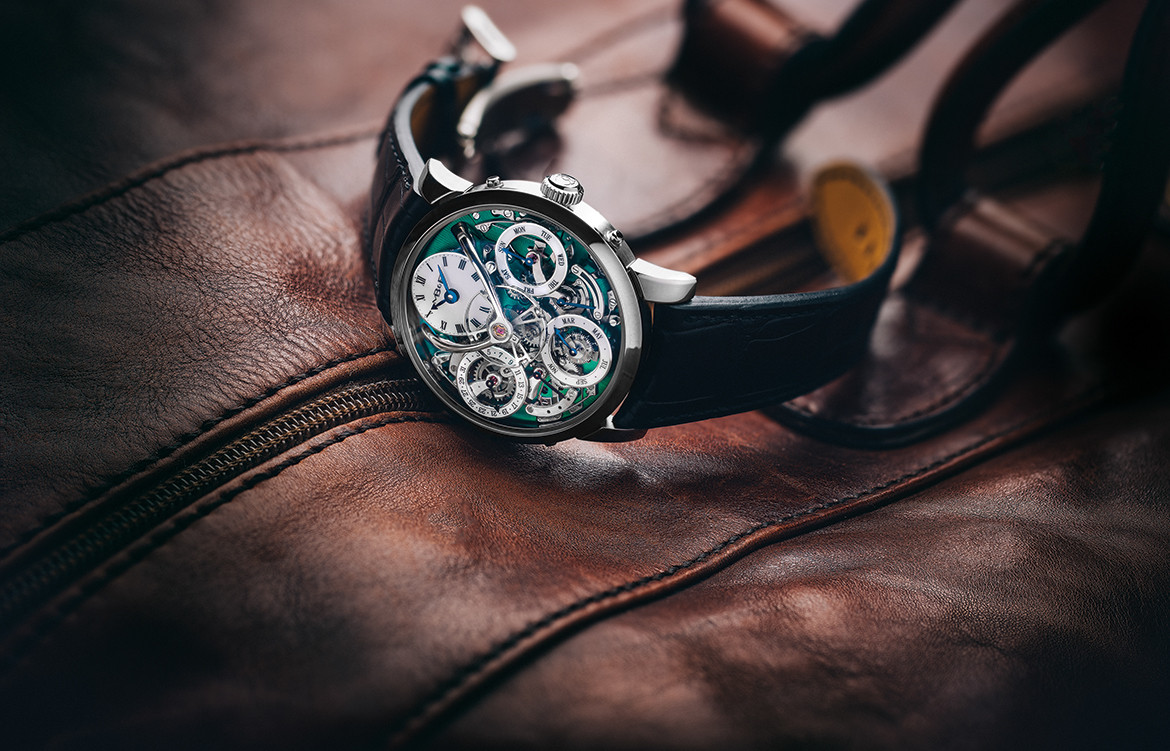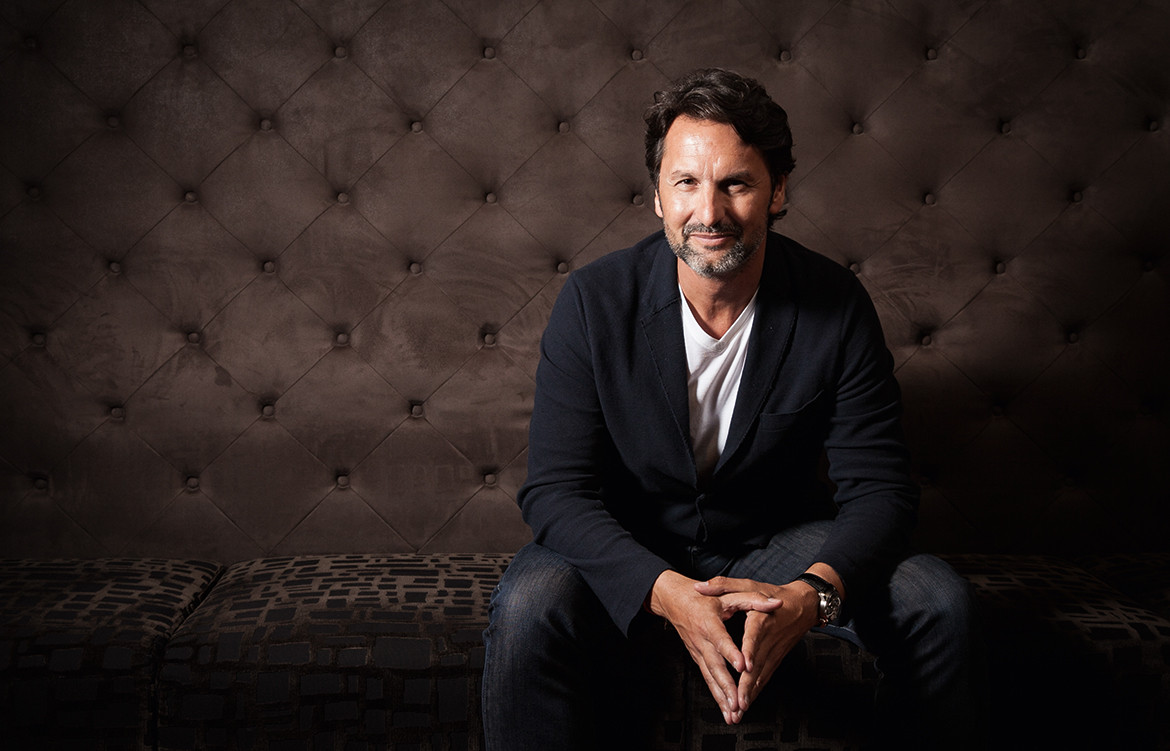In founding MB&F, you’re able to work for yourself – was this always an aspiration?
Yes, definitely. That was the dream. I created my company as a life decision. The whole reason can boil down to trying to be proud of myself on the last day of my life. To look back and say, you did well; and to be happy.
I was extremely lucky to fall into watchmaking a long time ago. My first job in watchmaking was virtually dead; there was no mechanical watchmaking. After seven years at Jaeger-LaCoultre I was headhunted at 31 by Harry Winston – to become the Managing Director, which was the worst day of my life.
How do you mean?
So it should’ve been the most beautiful day of my professional life. What I had no idea was that Harry Winston Timepieces was virtually bankrupt. And everything in the company was wrong; I mean like often there’s two or three things wrong? Every cupboard, every drawer you’d open would blow up in your face. So I jumped on a plane the first week and went to head office in New York to meet the man who hired me. I told him “This is wrong, this is wrong, this is wrong! It’s a nightmare, we can’t even pay the salaries” And they looked at me and said “You know what? It’s your nightmare.
“Because we’ve got so many other things to deal with. Now, you wanted the job, you got the job, deal with it. And anyway if you don’t we’ll just bankrupt the company,” meaning that the watch division.
Right in the deep end from the first week!
I just thought I’d done the biggest error of my life. I worked, 12 to 18 months nonstop… it’s like the proverbial 18 hours day. I always had a pad and a pencil on my bedside table and wake up in the middle of those five hours of sleep going because I’d dream about working, “Oh we have to do that; we have to do that.” It was horrible.
How were you able to turn it around? What things did you audit and look at and change?
That’s a whole interview in itself! I think the first of all was trying to give a purpose to the company. These watches being made from the greatest greatest jeweller in the world at that time, and nobody actually wanted that division… nobody wanted those products. So first of all it was give it a purpose. I remember seeing the owner Mr. Winston saying, “look, you’re the greatest jeweller in the world, you need your watches to be at the same level.”
But, we were not a manufacturer, we didn’t have 200 years of history, and we didn’t create our own movements ourselves. We had none of the legitimacy you would expect of a luxury watchmaker, so we needed to create products that were as incredible as the jewellery; which means working and collaborate with great people
That was the first step that then led to a line called the Opus range at Harry Winston, which was about rare timepieces, equally rare mechanics, and rare diamonds.
The rare diamonds was easy – I was from Harry Winston diamonds after all. The rare mechanical movement was another cup of tea. So that’s when I sat down and started meeting all these independent, unknown watchmakers who were actually working as creators for other brands who never acknowledged them and I started discovering these incredible people who had all the ideas.

This is where the collaboration began?
This was the beginning of that, and then basically we had to do everything. We were eight people, seven employees and me, and everybody wanted to leave the company! Seven years later we’d gone from eight to 80 employees, eight to 80 million dollars. And I have never done anything like that, so I was discovering things. I was discovering that I was capable of being a CEO, doing that sort of job and having the ideas and hiring the right people.
As the company was growing though, the more I understood that I hated the job. It was very weird, because when you come from where I come from, you’re not allowed to hate that job. I was the poster boy of my generation. I was this young CEO who turned the company around, I had my face in newspapers and the money was rolling in. And I was feeling guilty.
For not enjoying the work?
When everybody wanted my job and I was feeling like I didn’t enjoy it, I just felt ungrateful basically. I was a very creative kid and I’d felt as if I’d basically sold out. I’d become a marketeer – creating products simply because that’s what the market wants. You do what you need to build a business, but as a creator I realised that’s one of the things I hated.
Is this what led to MB&F?
I realised that I could completely not accept where I was. And that’s why when I created the brand, I called it MB&F, Maximilian Büsser and Friends… it’s funny, everybody told me it’s the worst name! I mean, our first piece was $200k, and people were like “‘and Friends?'” Seriously?
What would you say is the sort of core DNA of MB&F?
One of the very important facts is thinking creatively what do we do? What we try to achieve is that I’ve always thought watchmaking was art, and everybody talks about the art of watchmaking, but then why are 99.9% of all watches more or less the same? The whole point of art is to go and explore the territories. So my point was, for me it’s a mechanical sculpture. Giving time is not the point. Not after the quartz revolution. So I deconstruct traditional watchmaking and reconstruct it into a kinetic piece of art which ‘oh by the way’ gives you the time. As it’s art, there’s always a story – and not a fake story, not like “Okay now we’ve created this boring product, let’s do a storytelling exercise.” It’s a genuine expression; something I didn’t realize at the beginning. When I MB&F started I had HM1, HM2, and a sketch of HM3… But it’s basically all coming back to my childhood.
When we launched the Aquapod, our diving watch, it was inspired by my wife getting stung by a jellyfish! On holiday we were all paranoid because there were jellyfish everywhere in the water, and so from there I just sort of imagined what would a mechanical jellyfish look like and transpose it into something you put on your wrist. So that’s the first of our creations which doesn’t stem from my childhood.
I was an only child and very lonely. I was the weird one, the one who didn’t fit in… Who dreamt of being popular and was absolutely not. So to escape that, my reality was my imaginary life.
So creativity was your outlet?
I was a superhero! When I was eight to ten years old, in my room in the afternoon I was Luke Skywalker; I was Han Solo; I was Captain Kirk! And today I’ve kept a big part of that in me. Now I’m over 50, I’m a pretty level headed person, but If there’s one button which you should never press with me, it’s when I feel somebody is doing something which is unfair. That superhero complex comes out.
Who would you say are the people who wear your watches?
Initially I didn’t imagine anybody because I thought you’d be absolutely off your rockers to actually own one of mine! Then I’ve discovered over the years that our clients all over the world are more or less the same sort of people, which was really interesting. There is no uniformity of colour, race or religion – put them side-by-side and they absolutely don’t look the same but in their minds they’re the same people.
They’re often entrepreneurs, meaning they’ve got their own company. You need to be a little self-asserted to own one of my pieces, or to like what I do. You aren’t a follower; you don’t want to be somebody like everybody else. They’re people who’re in touch with their own feelings, because the whole point of having one of our pieces is being part of a journey, of our journey at least! When I talk with our clients, 50% of the reason of buying one of my pieces is the MB&F journey.
And 50% is the product itself, where they say, “Wow, this blows my mind, I know everybody’s going to hate it, nobody will understand it but I want this piece.” There is a big element of being sure of your taste, which means all sorts of different things; in design, in architecture, in life.
You limit the number of MB&F watches you produce regardless of demand, how did this approach come about?
Well there are many reasons. The first one is because I want to keep my company small. What we’ve managed to do is have zero middle management. That was one of the main reasons. As my company will not grow, what keeps me up at night today is mostly how do I keep these great people in my team. Not growing has enabled me in the last four years, to grow awareness of the brand organically. We have no advertising budget, it’s all word of mouth and when you do 20 pieces a month for the whole world, there is no way even if we had any money for advertising people would even see it, so it’s all word of mouth. And so, we end up having more and more awareness, the demand is higher every year, but we don’t grow.

In terms of retailers, what do you like about The Hour Glass (an exclusive MB&F distributor) and how do you feel that’s a good sort of relationship?
I only have 25 retailers in the world, and The Hour Glass was one of the six at the very beginning. At the start, I put all my money into the company, and lived without salary for two years, working from my little flat and I very quickly realized there’s no way this is going to take off. So after three months I went around the world for three weeks, and I went to see all the retailers I knew well from my Harry Winston days, with a drawing of the first piece, and my whole concept of horological machines. I was trying to get orders, knowing I would deliver two years later. But more importantly, I was trying to find anybody who’s nuts enough to partner up with me. I don’t think MB&F will ever leave The Hour Glass.
What about MB&F’s Australian presence?
The Hour Glass here was moving far less than in Singapore. It was two or three a year compared to 50 to 60. So at the beginning of this year we sat down with the whole team and said “Okay, let’s really give it a try.” And so we’re now offering a much bigger assortment to see if they can actually make it take off.
I know my watches are unique and not for everyone, but it’s like with people – beauty fades, intelligence doesn’t. At end of the day, do you want to be with somebody who’s beautiful but there’s nothing behind it? Or would you rather be with someone who’s got incredible depth.
I know where I would stand.
MB&F
mbandf.com
The Hour Glass
thehourglass.com

